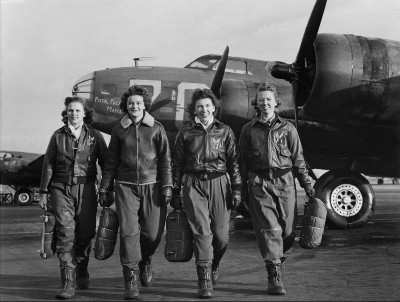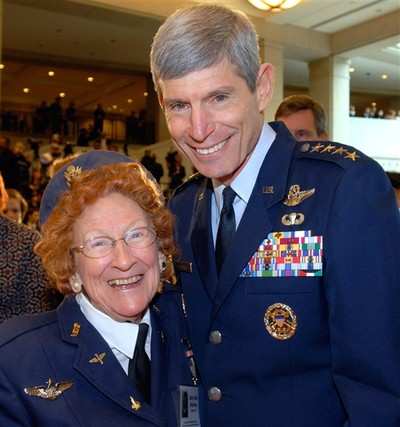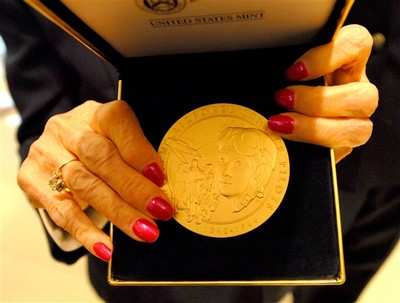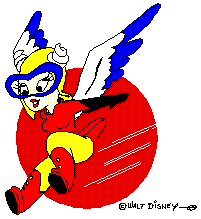WASP -- Women Airforce Service Pilots -- and Real-Life
"Dimpler" Make Rare Appearance at Guest Symposium In March
While the women of WWII are credited as being the first to
shatter the glass ceiling, it wasn't an easy ride. Barry Smith and
other women of her time recall that although they were eager to
serve, the men in the military weren't quite as ready for the
change.

On March 4 and 5, in honor of Women's
History Month, the public will have the rare opportunity to meet
and hear firsthand from some of these women who during WWII took
jobs traditionally held by men and the unique consequences that
today would be unheard of. The two-day forum, called
"Breaking all Barriers," will feature two of the original
WASP--Women Airforce Service Pilots--the first women to pilot U.S.
military aircraft, as well as a real-life "Rosie the Riveter," who
took a grueling factory job to support the war effort
overseas.
One of the only attractions in the country to bring together
legendary WWII heroes to share their firsthand accounts, Fantasy of
Flight recently expanded on its highly popular "Living History
Symposium Series" that has introduced aviation heroes to Fantasy of
Flight guests for the past two years. "Legends & Legacies"
combines WWII aviation heroes, such as the WASP - who offer a
glimpse of what it was like to fly in the heyday of aviation as
they protected their country - with their families, who have their
own unique insights to share. The series also includes heroes from
WWII who served on the ground protecting and supporting the men and
women in flight. Each symposium features several
open-forum/question-and-answer sessions, followed by
meet-and-greet/autograph signing sessions.

Betty "Wall" Strofus, USAF Chief of Staff Norton
Schwartz
WASP Barry Vincent Smith, returning to
Fantasy of Flight for a second time, and Elizabeth "Betty" Wall
Strohfus, making her first Fantasy of Flight appearance, will
recount what it was like to leave their homes and jobs at the
height of WWII to serve their country as the first American women
to fly for the U.S. military. When every available American male
pilot was absorbed into combat overseas, dangerous non-combat
flight duty still required pilots stateside for ferrying, testing,
dragging targets and liaison - tasks hardly suited for the
inexperienced or the faint of heart. The WASP bravely stepped
forward to fill that void and aid in the war effort.
Last year, hundreds of the original WASP met on Capitol Hill to
receive the Congressional Gold Medal, the highest award a civilian
can receive from the United States Congress, which is bestowed only
upon those who have performed an outstanding act of service for
their country. President Barack Obama signed the bill into law in
July 2009 to grant the WASP this great honor.

WASP Congressional Gold Medal
Only 1,830 of the 25,000 applicants
were accepted into the WASP program, and 1,074 of those women
earned their silver WASP wings. Their indomitable founder, Jackie
Cochran, became the first civilian to receive the U.S. Army
Distinguished Service Medal for her vision and leadership of the
WASP program.
"Breaking all Barriers" will also feature Opal Campbell, who worked
a factory job as a "dimpler" to support the war effort. The dainty
and diminutive Campbell was one of thousands of women who left the
comfort of their homes to take on tough jobs in factories that
produced munitions and war supplies. This social movement was
largely driven by "Rosie the Riveter," a 1942 song which was later
made into a propaganda campaign by the U.S. Government to encourage
women to join the workforce. It is estimated that by 1944, 20
million women were working, a 57 percent increase from 1940.
The symposium will bring to life the experiences of Smith, Strohfus
and Campbell through open-forum/question-and-answer sessions as
well as permanent and semi-permanent exhibits and real aircraft.
Fantasy of Flight's WASP exhibition, which includes aircraft as
well as four separate bays that feature historical, anecdotal, and
inspirational newsreel footage, original photos, and storytelling
panels from the 1940s and today, will serve as the backdrop for
historic appearances from the real pilots.
"Talk about shattering the glass ceiling!" said Kermit Weeks,
founder and creator of Fantasy of Flight. "When these brave women
stepped forward to become pilots and work outside their homes, they
gave women for generations to come the permission to dream
big."

Barry Vincent Smith was 21 years old,
living with her parents in Chittenango, N.Y., when her brother, who
had recently enlisted in the Air Force, wrote her a letter telling
her she'd "better learn to fly" because women would soon get a
chance to pilot military aircraft. Smith went out the next day and
found a flight instructor, whom she paid $14.50 per one hour
lesson, more than half of her weekly salary at the phone company.
After logging the 35 required hours of flight time necessary to
apply for WASP, the small town girl took a train to New York City,
by herself, for her interview and was accepted into the WASP
program. She had to wait six months, until Jan.1, 1944, to start
her training at Avenger Field in Sweetwater, Texas, where she flew
day and night, dual and solo, piloting aircraft such as the AT-6,
BT-13 and Stearman.
The former pilot hopes that symposium attendees will be inspired by
her story. "I think they should know what it was like during those
times. For example, how much money we were making, what things cost
and how it made it harder to do what we wanted. If I had gone
through college it would have been easier but I hadn't done that
yet..." said Smith. "We had to get 35 hours of fly time before
interviewing to be a WASP. Lessons were $14.50 an hour, it took me
about eight weeks to complete and (I) sometimes had to walk four
miles to get where I was going."

Elizabeth "Betty" Wall Strohfus had
graduated from high school, been bitten by the aviation bug and was
taking flying lessons when she first heard about the WASP program.
Just shy of 5'3", the tiny pilot needed extra socks to help her
meet the minimum height requirement, but she graduated among the
first WASP class of 1944, the ninth WASP class overall. While most
graduates went on to assignments ferrying aircraft, Strohfus
volunteered to fly pursuit aircraft, towing targets behind a B-26
for fighter target practice, and diving at bombers in pursuit
aircraft and at infantry in the AT-6 for gunnery and anti-aircraft
target practice. During her year of WASP service, she flew eight
different aircraft including the B-17, B-26, P-39, and her
favorite, the AT-6, often sitting on cushions to be able to reach
the controls. Strohfus also received her instructor certification
to teach instrument flight to male cadets, who were always shocked
to find out their instructor was a woman. Twice she was forced to
choose between a relationship and her WASP career. Twice, she chose
flying. Of her one-time fiancé, Strohfus recalled, "It was
between him and the AT-6, and I chose the AT-6." Strohfus
served as a WASP from 1943 until WASP were disbanded in December
1944. Although the cancellation of the program left her and other
WASP with "broken hearts," Strohfus said, "I have no regrets. I
just feel lucky that I got to fly."
In later years, Strohfus was central in lobbying congress for the
recognition of WASP as veterans. The law was passed and signed in
1977 that allowed the Secretary of Defense to declare in 1979 that
service in the WASP was active military service and those serving
were veterans. She is a member of the Ninety Nines, Confederate Air
Force and in 2001 was inducted into the Minnesota Aviation Hall of
Fame.
 ANN's Daily Aero-Linx (05.06.25)
ANN's Daily Aero-Linx (05.06.25) ANN's Daily Aero-Term (05.06.25): Ultrahigh Frequency (UHF)
ANN's Daily Aero-Term (05.06.25): Ultrahigh Frequency (UHF) ANN FAQ: Q&A 101
ANN FAQ: Q&A 101 Classic Aero-TV: Virtual Reality Painting--PPG Leverages Technology for Training
Classic Aero-TV: Virtual Reality Painting--PPG Leverages Technology for Training Airborne 05.02.25: Joby Crewed Milestone, Diamond Club, Canadian Pilot Insurance
Airborne 05.02.25: Joby Crewed Milestone, Diamond Club, Canadian Pilot Insurance







